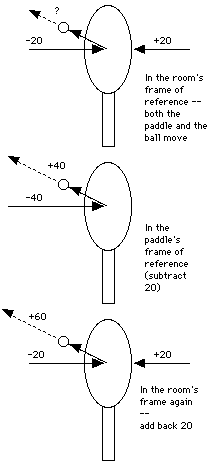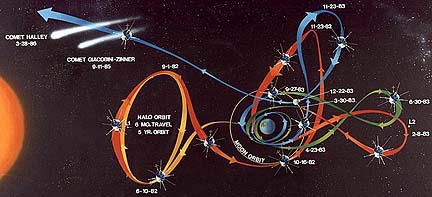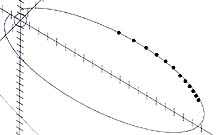(35) To the Planets, to the StarsElastic CollisionsIn a game of ping-pong, suppose a paddle moves at 20 miles per hour and hits a ball with 20 mph in the opposite direction. With what velocity does the ball bounce back?(Replace 20 mph with 10 m/sec, if you prefer to use metric units.).

A general problem of this sort, with ball and paddle both moving at an angle, requires the use of vectors. But head-on collisions are simpler, for velocities can then be viewed as positive in one direction and negative in the opposite one. We then can imagine a ball traveling at -20 mph meeting a paddle moving at +20 mph (top figure; the rebound is drawn at an angle, though it is really in the opposite direction). What happens next? In any problem involving forces, adding the same velocity to all motions does not change the physics. Inside a jetliner moving at 600 mph dropped objects fall straight down, just as they do inside a house. The reason is, of course, that adding 600 mph to all motions leaves accelerations (changes in velocity) the same, and by Newton's laws, only accelerations count. We may therefore add -20 mph to all velocities. The paddle's velocity is now zero--which means we are moving with it or "are in its frame of reference"--while the ball now moves at (-20) - 20 = -40 mph (middle drawing). In the new problem, a ball moving at -40 mph hits a non-moving surface; if the collision is elastic (no energy lost), that ball returns with the same speed but in the opposite direction, i.e. its velocity reverses sign. Its rebound velocity is therefore +40 mph. Finally we return to the real world, by adding +20 mph to all velocities. The paddle now has again 0 + (20) = 20 mph, its original velocity, while the ball has 40 + 20 = 60 mph. Colliding with the moving paddle has increased the ball's speed v by twice the paddle's velocity, and since kinetic energy goes as v2, the tripling of the speed from 20 to 60 mph means that energy has increased 9-fold! The extra energy was supplied by the paddle and by the hand holding it. Planetary Swing-bySomething very similar happens when a spacecraft with velocity v passes close to a moving planet and is deflected. If the planet moves at velocity V, the satellite may gain or lose energy, depending on the angle between the motions and also on the angle of deflection, which in its turn depends on how close to the planet the satellite passes. As with the ping-pong ball, the greatest gain of speed and energy occurs when the two move in opposite directions and the satellite gets so close to the planet (passing behind it) that its direction of motion is (nearly) reversed. In that case, as with the ball, the satellite emerges with velocity v + 2V. The impressive images returned by Voyagers 1 and 2 and by Pioneers 10 and 11 stirred the public interest and added enormously to what was known about those planets and their satellites. What the public might not have realized was that not only were these planets worthy targets for exploration, but their gravity pulls were an essential ingredient making this "grand tour" possible. To reach Neptune at the outer edge of the solar system, Voyager 2 needed a great deal of extra velocity to overcome the pull of the Sun. Rather than obtaining that velocity from rocket power, the "Voyager" and "Pioneer" space probes used close encounters with moving planets. The encounter with Jupiter provided Voyager 2 with the velocity needed to reach Saturn; its encounter with Saturn made possible the next leg of the journey to Uranus, and so on. The moving planets themselves provided the energy. |

|
This sort of maneuver is often used by interplanetary probes. Encounters with the Moon have also been used, for sending spacecraft towards the Lagrangian L1 point or the L2 point in the tail, for modifying missions (such as that of Geotail) and on December 22, 1983 for sending ISEE-3 away from Earth towards Comet Giacobini-Zinner (the figure above describes its orbit, which includes several encounters with the Moon, on the dates given). Even encounters with the Earth itself have been used this way, by the space probe Galileo now orbiting Jupiter: the probe first went to Venus, then came back to swing by Earth. All this looks like a cosmic game of billiards, except that the "cue ball," the satellite making the encounters, carries its own small rocket engine, to correct its course as needed and thus make complex shots possible. The first use of this maneuver was by Mariner 10 launched in 1973 towards Venus, which used that planet's gravity to extend its own orbit to the planet Mercury. The probe Ulysses used an encounter with Jupiter in order to fling itself out of the ecliptic, into an orbit passing above both poles of the Sun. And NASA's "solar probe," intended to come within 4 solar radii of the center of the Sun, may use a tight "hairpin" trajectory around Jupiter as well. An interesting parallel exists between Planetary swing-by maneuvers and the operation of the Pelton water turbine. More on this in section #35a, Planetary Swing-by and the Pelton Turbine.To the Stars
Close encounters with attracting planets have another use: the effect of any rocket thrust applied at closest approach is greatly amplified. A proposed "Profile" mission to the Earth's magnetosphere calls for a dozen small satellites placed initially aboard a "mother ship" in a long elliptical orbit. At each closest approach ("perigee") one satellite is tossed out, at no more speed than that of a runner in a footrace, yet that boost is enough, by the next closest approach, to make it lag by one hour. The next satellite is then tossed out, and so on, one at each closest approach. In the end all satellites are strung out one hour apart in the new orbit (drawing on right), which differs slightly from the orbit of the mother ship. A rather gentle push does it all, but it must be delivered at the right place. Some day in the far future humanity will probably want to send robot explorers to the distant stars, journeys that may require many thousands of years. Long ago it was proposed that a good way to achieve the required speed would be to first pass close to the Sun, and at the closest approach fire a rocket. Even a modest increase in speed near the Sun then translates to a great increase in the ultimate velocity far away. Unfortunately, this requires getting rather close to the Sun, and the space probe is likely to melt. A more reasonable start for a mission to a star may be from a comet, because the trajectories of comets already extend to the edge of the solar system, and the ice found on them may provide hydrogen and oxygen for fueling rocket motors. In this manner the stars nearest to Earth might be reached. To reach more distant parts of the galaxy, however, may require close encounters like those proposed with the Sun. Dwarf stars exist which are as compact as Earth and as massive as the Sun, and perhaps some can be located that are burned out, dark and cold. If so, they would be a perfect target for such a maneuver. All that is now just pure fantasy: but humanity has the time, its venture into space is just beginning. |


